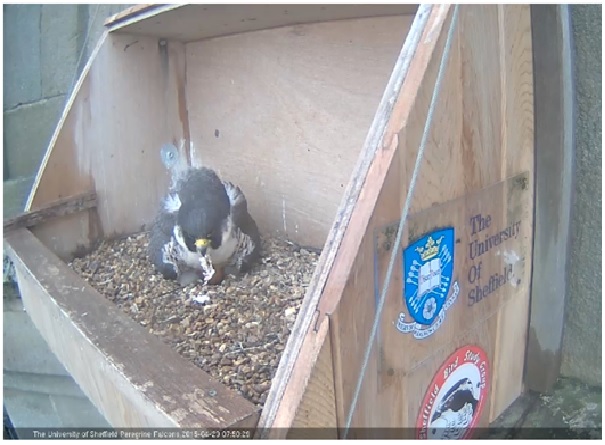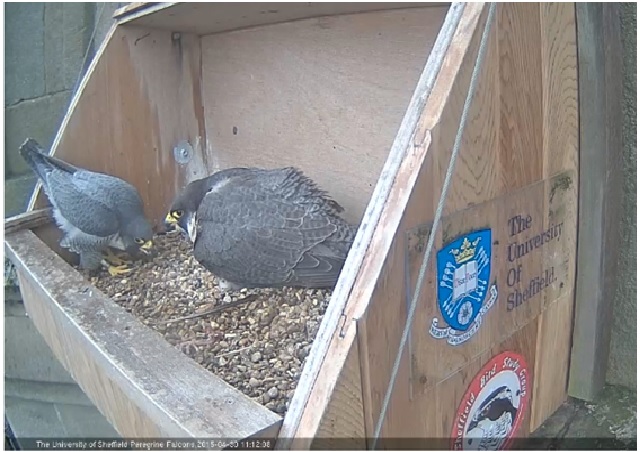Just about a week on from the first chick having hatched and we seem to have come to a halt with just the two chicks this year, the second having hatched by 07:00 on Tuesday 29th, according to brief glimpses seen under the female.
Something that was very evident was the shell from the egg from which the chick had just hatched, and the female soon proceeded to eat the shell, a well-known piece of behaviour that will presumably replace calcium, much of which will have been given over to the eggs during laying.
With two chicks hatched in quick succession, all looked set for a repeat of last year’s scenario and the hatching of all four eggs. However, as the hours and days rolled by no further ‘chips’ in the eggs could be seen (despite a couple of moments of hope) and as things stand it may well be that we have two chicks this year, as we did in 2012.
The male has been keen to take over from the female on incubation/ brooding duties, though the female has at times been reluctant to hand over – as in the screengrab above, where the size difference is very obvious. This has been the case both for brooding and at times when he’s come in with prey to offer a feed.
Something I’d not noticed before was that when food was being offered to the chicks in the first few days, each time the female was ready with a tiny morsel in her bill she called quietly to get the chicks’ attention. This will be because the chicks are born with their eyes closed and have very poor vision for the first days they are open, which means for much of the first week.
Things have settled into a routine of brooding and regular feeds, with regular comings and goings and the chicks left unattended only briefly as they remain vulnerable to predation by Crows or possibly Lesser Black-backed Gulls, with both species over and around St George’s from time to time.
Why have only two eggs hatched this year after three in 2013 and all four in 2014? There are several possible reasons: the eggs may not have been fertile when laid; the first (and second) eggs laid may have become chilled when left unbrooded in unseasonally chilly weather; or perhaps the female is losing breeding condition as she becomes older – the number of eggs laid and chicks hatched both tend to decline over the years. It’s still possible that another egg will hatch, though increasingly unlikely as they would normally be expected to hatch over a period of some 48 hours. Last year we had the first chick hatch on April 28th (as this year), and by April 30th we had all four hatched. The female is still incubating the eggs and pulling them underneath her, but as the chicks grow they require more of a gap between her and the gravel, which in turn will presumably reduce the heat received by the eggs.
A visit to St George’s this morning provided plenty of good views as both adults came and went, taking turns on the nest. The male is often perched up out of sight of the webcams when he’s not on the nest, so all seems to be going well, even if we only have the two chicks to enjoy.






Very many thanks for an excellent and informative report. You are keeping alonely old man very happy for which I thank you from the bottom of my heart.A little disappointing only two eggs hatching this year,but we have had somechilly weather and the parents did seem to leave the eggs untended for long periods. Anyway two healthy chicks is something to celebrate. Thanks once again keep up the good work, by the way the photography is awesome.
Thank you for the information.We have also noticed from previous years that on hatching both birds are seen what looks like eating of the eagg shells and were wondering if this is a behavioural thing to ‘get rid’ of evidence of chicks in the nest to prevent predation..Thoughts?
I thought a few days ago that I saw a pale patch on one of the unhatched eggs, and was hoping this was a sign of the chick beginning to peck it’s way out. But could it be that the egg was damaged by a talon or beak during the parents’ periodic rearrangement of the clutch, thus causing failure to hatch?
From the first egg laid , right up to the present moment I have enjoyed the whole situation. It’s a pity the other two eggs are now beyond hope , but the coverage is superb. Many thanks .
Has one of the adults got a bad foot??
Brilliant reports and images many thanks to the team
whats happed to the young peregrines 2015